CONSTITUTIONAL MONARCHY THE BritiSH EMPIRE the turn of

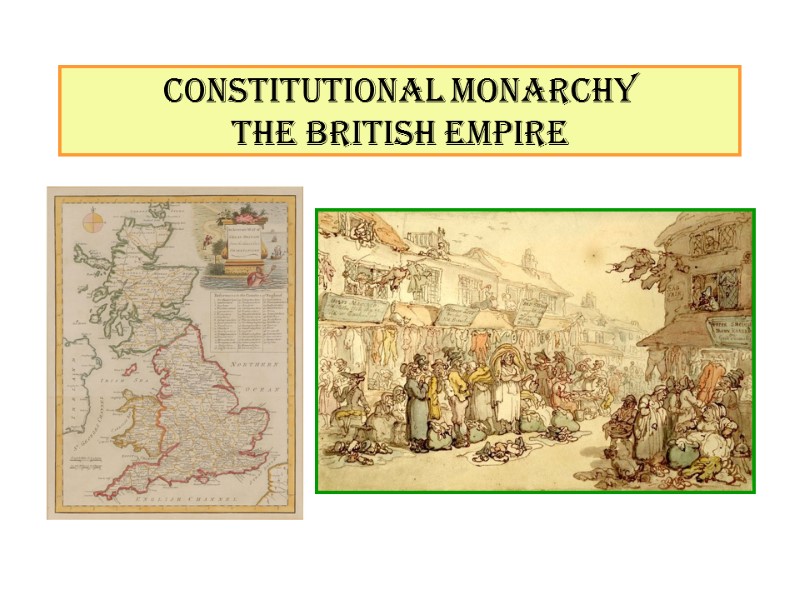
CONSTITUTIONAL MONARCHY THE BritiSH EMPIRE
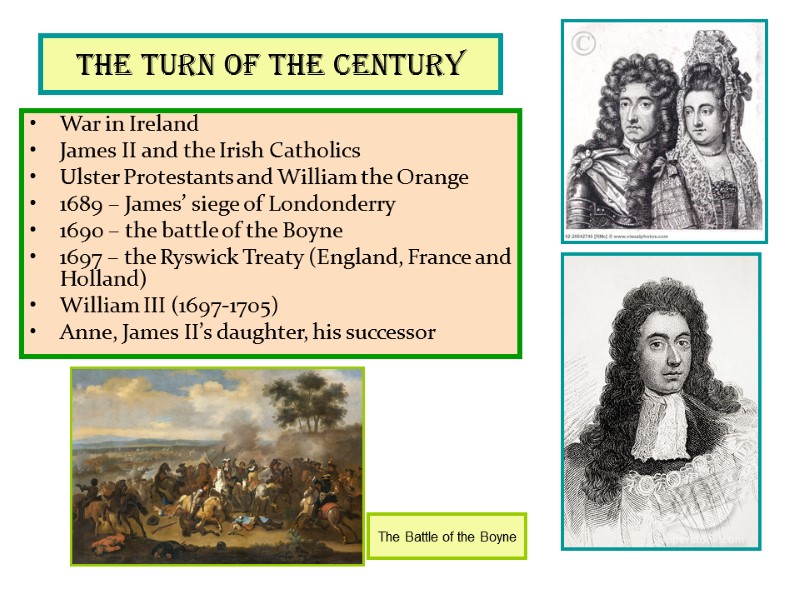
the turn of the century War in Ireland James II and the Irish Catholics Ulster Protestants and William the Orange 1689 – James’ siege of Londonderry 1690 – the battle of the Boyne 1697 – the Ryswick Treaty (England, France and Holland) William III (1697-1705) Anne, James II’s daughter, his successor The Battle of the Boyne
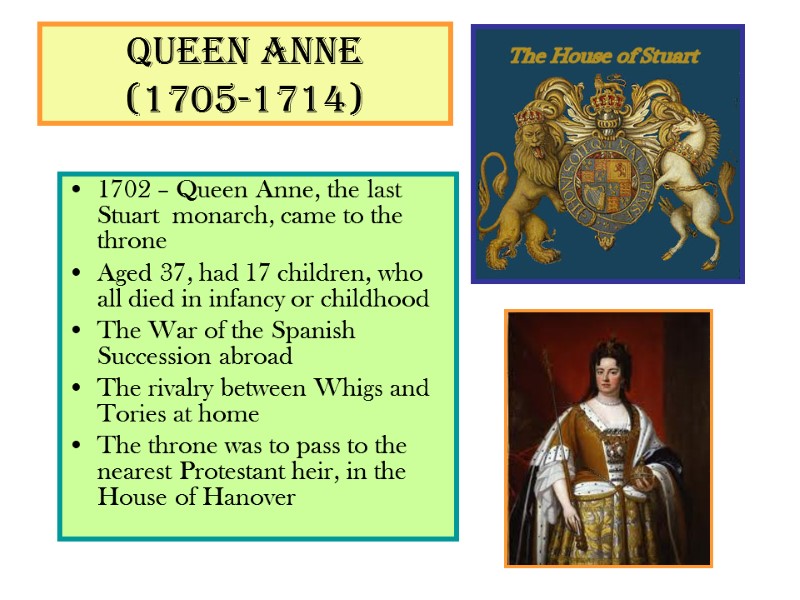
Queen Anne (1705-1714) 1702 – Queen Anne, the last Stuart monarch, came to the throne Aged 37, had 17 children, who all died in infancy or childhood The War of the Spanish Succession abroad The rivalry between Whigs and Tories at home The throne was to pass to the nearest Protestant heir, in the House of Hanover
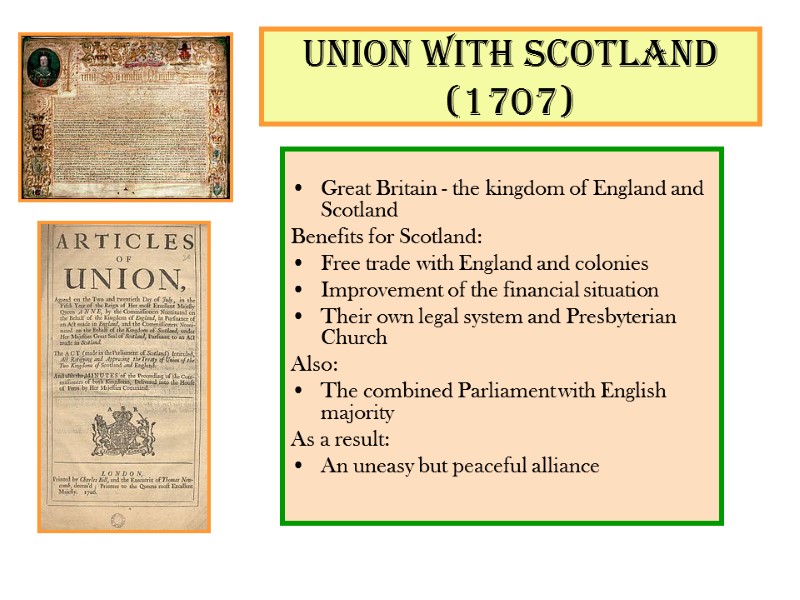
Union with Scotland (1707) Great Britain - the kingdom of England and Scotland Benefits for Scotland: Free trade with England and colonies Improvement of the financial situation Their own legal system and Presbyterian Church Also: The combined Parliament with English majority As a result: An uneasy but peaceful alliance
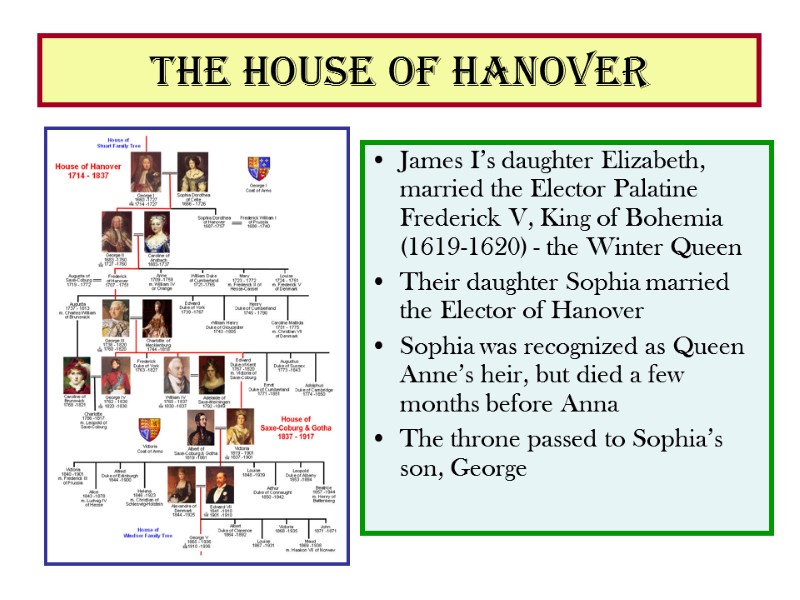
The House of Hanover James I’s daughter Elizabeth, married the Elector Palatine Frederick V, King of Bohemia (1619-1620) - the Winter Queen Their daughter Sophia married the Elector of Hanover Sophia was recognized as Queen Anne’s heir, but died a few months before Anna The throne passed to Sophia’s son, George
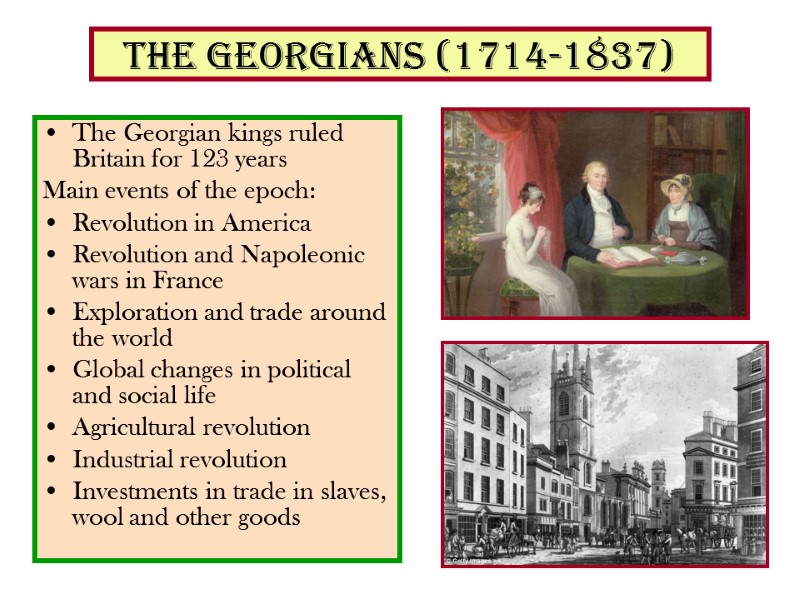
THE GEORGIANS (1714-1837) The Georgian kings ruled Britain for 123 years Main events of the epoch: Revolution in America Revolution and Napoleonic wars in France Exploration and trade around the world Global changes in political and social life Agricultural revolution Industrial revolution Investments in trade in slaves, wool and other goods
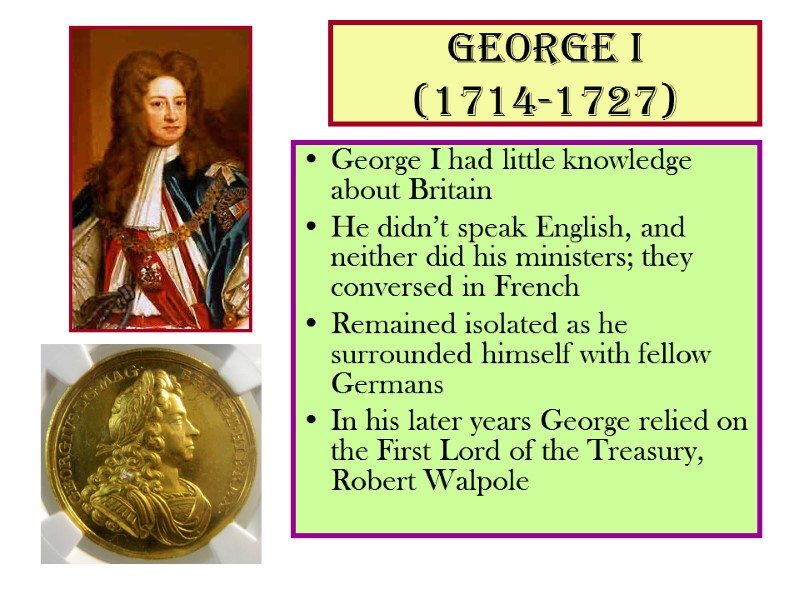
George I (1714-1727) George I had little knowledge about Britain He didn’t speak English, and neither did his ministers; they conversed in French Remained isolated as he surrounded himself with fellow Germans In his later years George relied on the First Lord of the Treasury, Robert Walpole
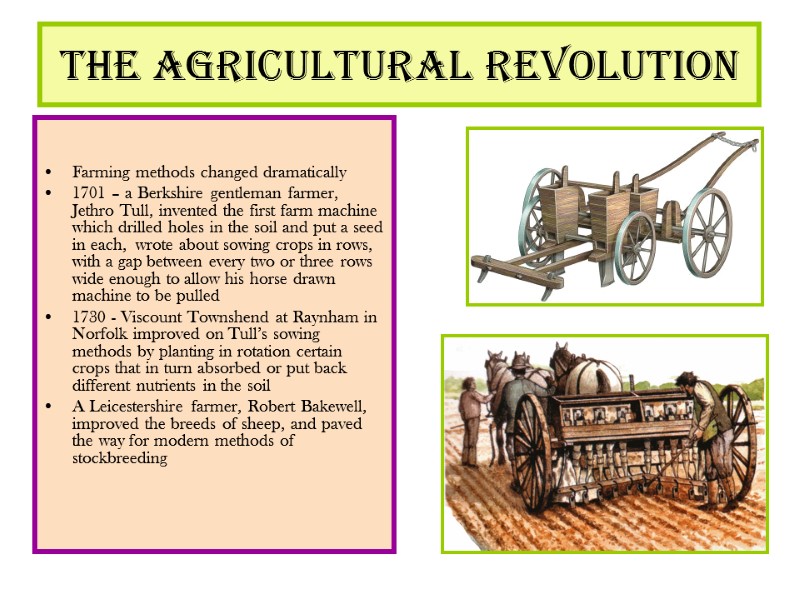
The Agricultural Revolution Farming methods changed dramatically 1701 – a Berkshire gentleman farmer, Jethro Tull, invented the first farm machine which drilled holes in the soil and put a seed in each, wrote about sowing crops in rows, with a gap between every two or three rows wide enough to allow his horse drawn machine to be pulled 1730 - Viscount Townshend at Raynham in Norfolk improved on Tull’s sowing methods by planting in rotation certain crops that in turn absorbed or put back different nutrients in the soil A Leicestershire farmer, Robert Bakewell, improved the breeds of sheep, and paved the way for modern methods of stockbreeding
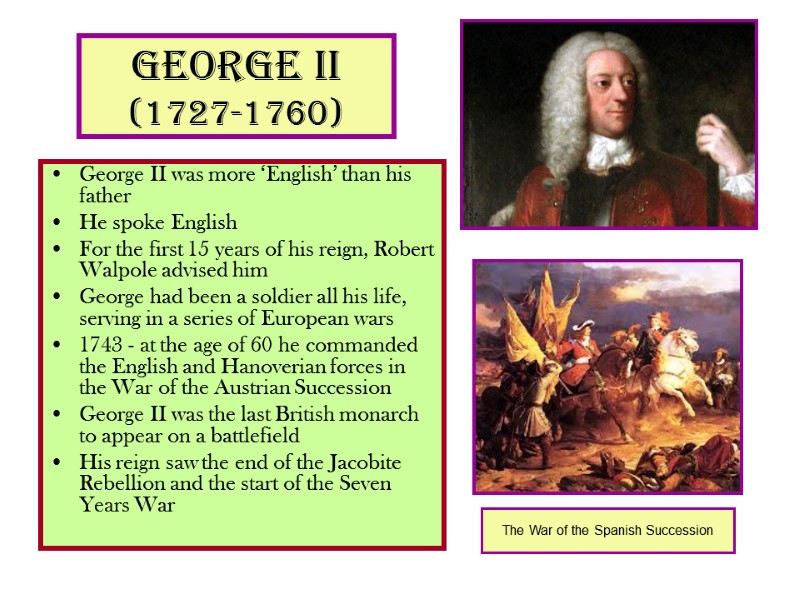
George II (1727-1760) George II was more ‘English’ than his father He spoke English For the first 15 years of his reign, Robert Walpole advised him George had been a soldier all his life, serving in a series of European wars 1743 - at the age of 60 he commanded the English and Hanoverian forces in the War of the Austrian Succession George II was the last British monarch to appear on a battlefield His reign saw the end of the Jacobite Rebellion and the start of the Seven Years War The War of the Spanish Succession

The Jacobite movement Aimed at the revival of the Stuart dynasty 1715 - Scottish Jacobites rebelled, supported by a small revolt in the north of England The ‘Fifteen’ was suppressed James Edward Stuart, the Old Pretender, son of James II, who had arrived from France, found the rising over and went away again

Bonnie Prince Charlie (1720-1788) 1745 - the Old Pretender son, Charles Edward Stuart, the Young Pretender or Bonnie Prince Charlie, arrived in Scotland Only a few clans supported him Charles’ army captured Edinburgh and moved south England to Derby April 15, 1746 – Jacobites were beaten at the battle of Culloden Many chiefs were executed The clans were banned from wearing tartan or playing bagpipes The government put a price of 30,000 pounds on Charles’ head None of the clansmen betrayed him Charles remained a fugitive for five months Escaped to France
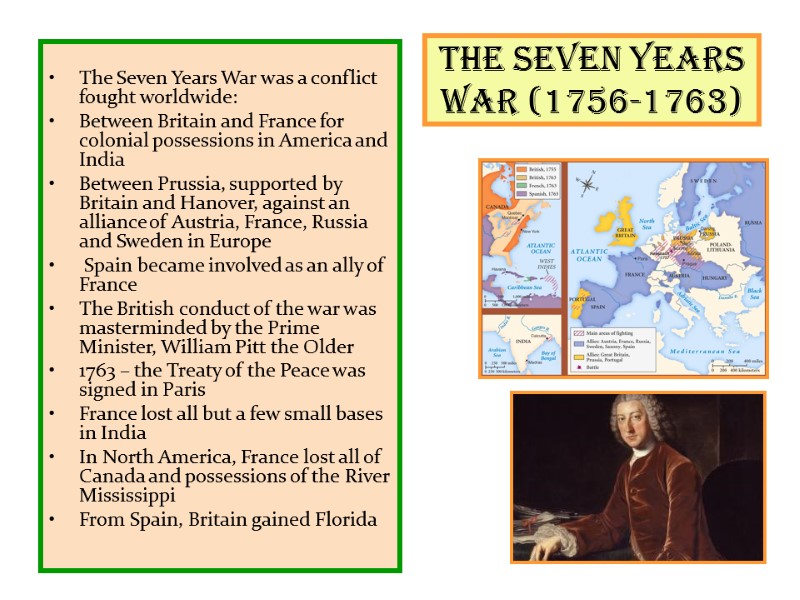
The Seven Years War (1756-1763) The Seven Years War was a conflict fought worldwide: Between Britain and France for colonial possessions in America and India Between Prussia, supported by Britain and Hanover, against an alliance of Austria, France, Russia and Sweden in Europe Spain became involved as an ally of France The British conduct of the war was masterminded by the Prime Minister, William Pitt the Older 1763 – the Treaty of the Peace was signed in Paris France lost all but a few small bases in India In North America, France lost all of Canada and possessions of the River Mississippi From Spain, Britain gained Florida

George III (1760-1820) The first Hanoverian king to be born and educated in England From 1811 to 1820 suffered poor mental health His son ruled as Prince Regent ‘Revolutionary Years’: The revolutionary processes in America, in other colonies, and in Europe Great political and social changes Fight for civil rights and freedoms The matter of the freedom of speech
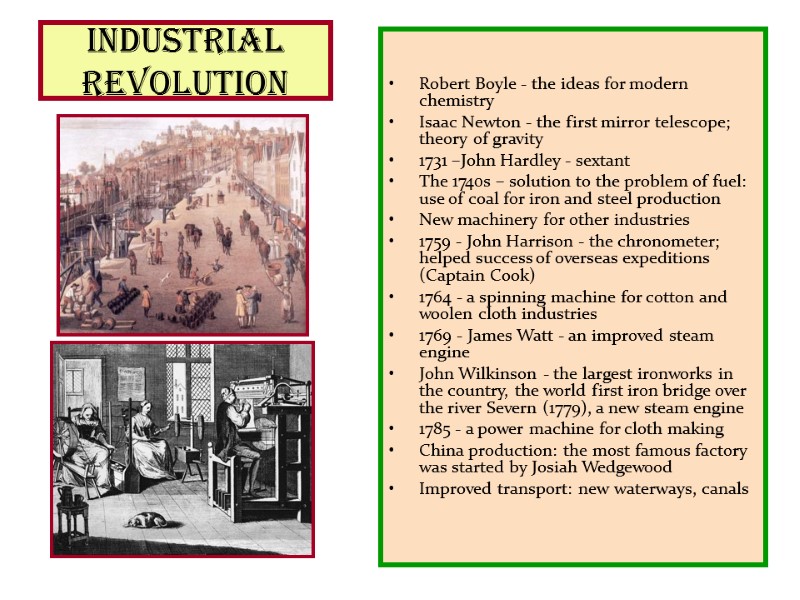
INDUSTRIAL REVOLUTION Robert Boyle - the ideas for modern chemistry Isaac Newton - the first mirror telescope; theory of gravity 1731 –John Hardley - sextant The 1740s – solution to the problem of fuel: use of coal for iron and steel production New machinery for other industries 1759 - John Harrison - the chronometer; helped success of overseas expeditions (Captain Cook) 1764 - a spinning machine for cotton and woolen cloth industries 1769 - James Watt - an improved steam engine John Wilkinson - the largest ironworks in the country, the world first iron bridge over the river Severn (1779), a new steam engine 1785 - a power machine for cloth making China production: the most famous factory was started by Josiah Wedgewood Improved transport: new waterways, canals
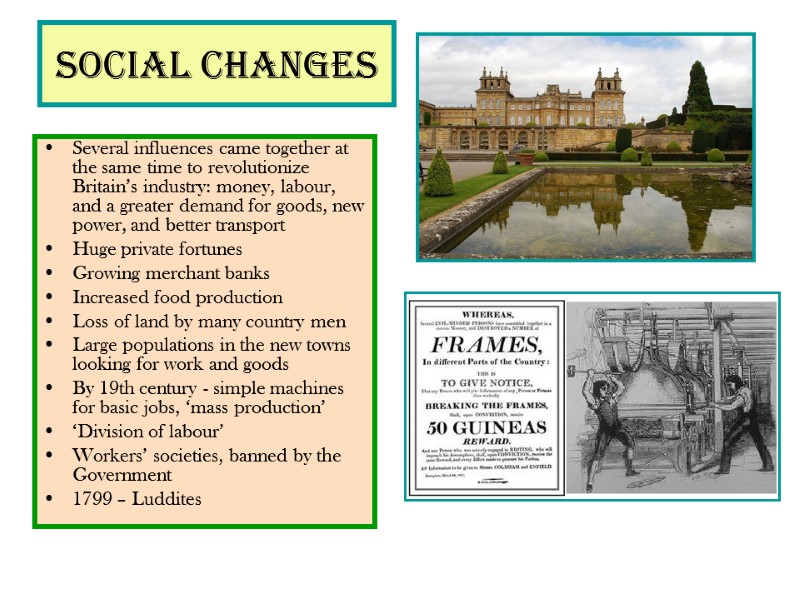
Social changes Several influences came together at the same time to revolutionize Britain’s industry: money, labour, and a greater demand for goods, new power, and better transport Huge private fortunes Growing merchant banks Increased food production Loss of land by many country men Large populations in the new towns looking for work and goods By 19th century - simple machines for basic jobs, ‘mass production’ ‘Division of labour’ Workers’ societies, banned by the Government 1799 – Luddites
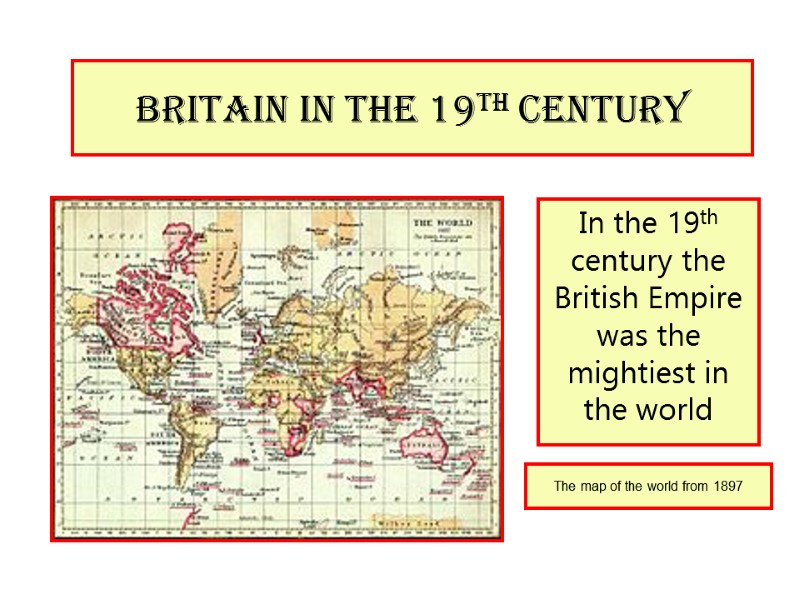
Britain in the 19th century In the 19th century the British Empire was the mightiest in the world The map of the world from 1897
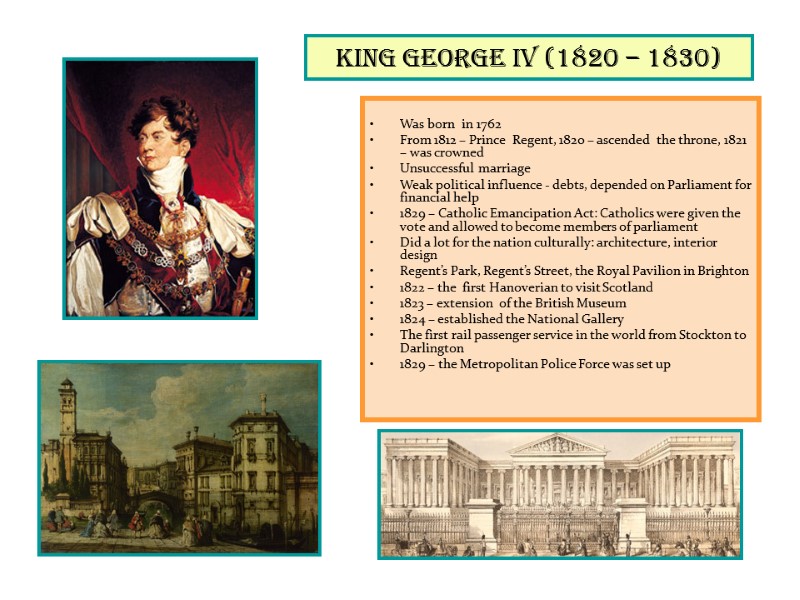
King George IV (1820 – 1830) Was born in 1762 From 1812 – Prince Regent, 1820 – ascended the throne, 1821 – was crowned Unsuccessful marriage Weak political influence - debts, depended on Parliament for financial help 1829 – Catholic Emancipation Act: Catholics were given the vote and allowed to become members of parliament Did a lot for the nation culturally: architecture, interior design Regent’s Park, Regent’s Street, the Royal Pavilion in Brighton 1822 – the first Hanoverian to visit Scotland 1823 – extension of the British Museum 1824 – established the National Gallery The first rail passenger service in the world from Stockton to Darlington 1829 – the Metropolitan Police Force was set up
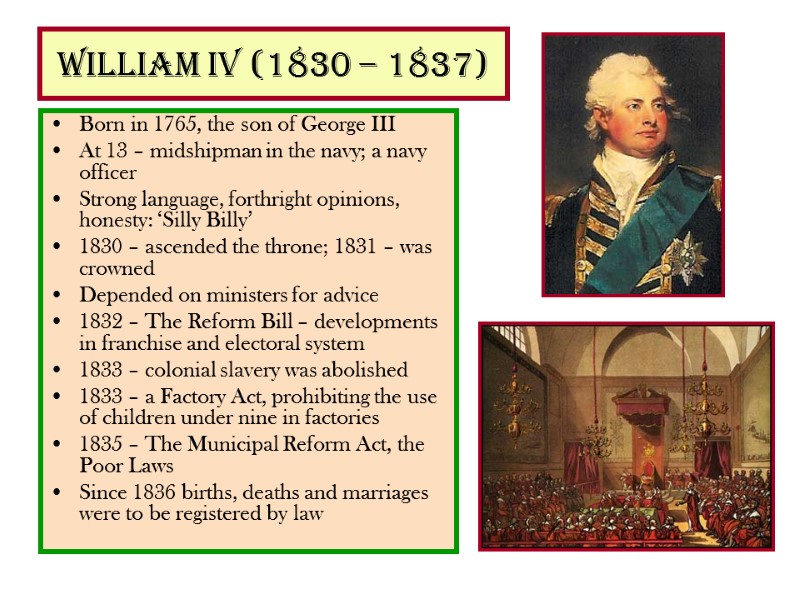
William IV (1830 – 1837) Born in 1765, the son of George III At 13 – midshipman in the navy; a navy officer Strong language, forthright opinions, honesty: ‘Silly Billy’ 1830 – ascended the throne; 1831 – was crowned Depended on ministers for advice 1832 – The Reform Bill – developments in franchise and electoral system 1833 – colonial slavery was abolished 1833 – a Factory Act, prohibiting the use of children under nine in factories 1835 – The Municipal Reform Act, the Poor Laws Since 1836 births, deaths and marriages were to be registered by law
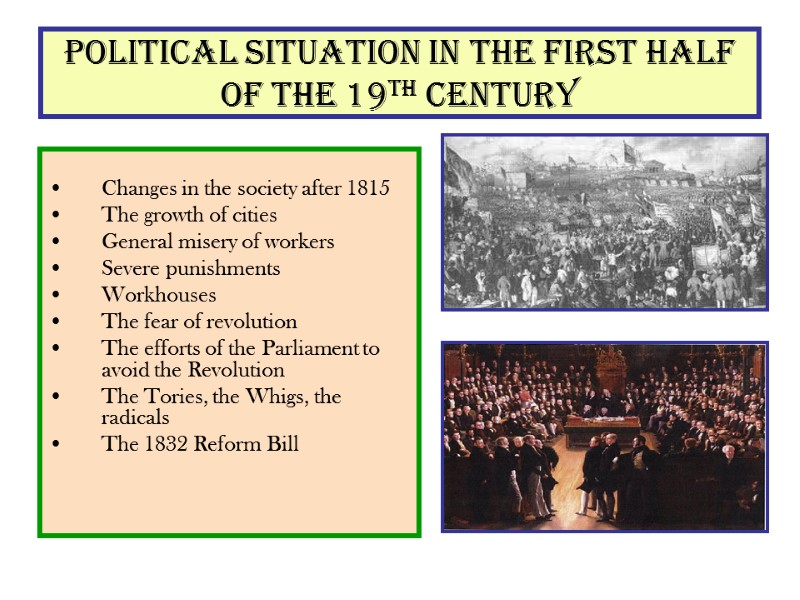
Political situation in the first half of the 19th century Changes in the society after 1815 The growth of cities General misery of workers Severe punishments Workhouses The fear of revolution The efforts of the Parliament to avoid the Revolution The Tories, the Whigs, the radicals The 1832 Reform Bill
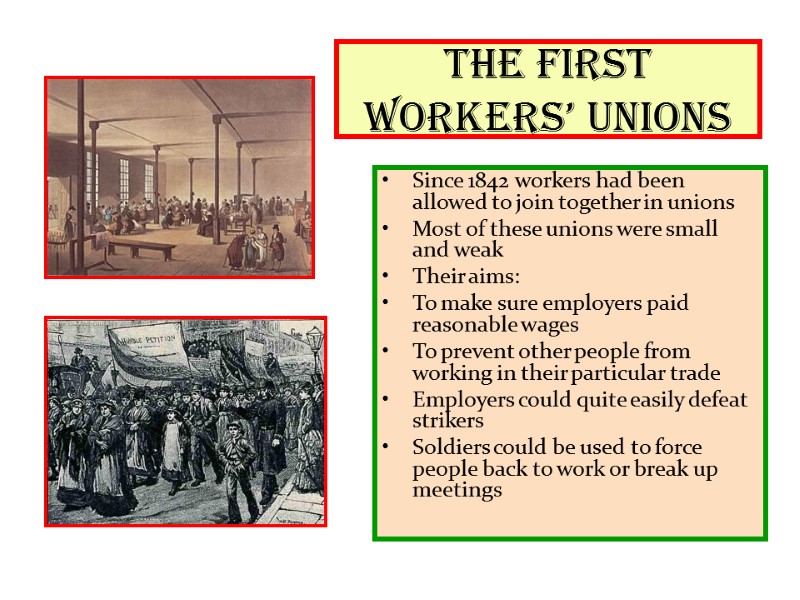
The first Workers’ Unions Since 1842 workers had been allowed to join together in unions Most of these unions were small and weak Their aims: To make sure employers paid reasonable wages To prevent other people from working in their particular trade Employers could quite easily defeat strikers Soldiers could be used to force people back to work or break up meetings

CHARTISM 1834 – Tolpuddle; 30,000 workers and radicals demonstration in London 1838 - working together for the first time, unions, workers and radical put forward a People’s Charter Demanded: The vote for all adults The right for a man without property of his own to be an MP Voting in secret Payment for MPs An election every year. The House of Commons refused all these demands Riots and political meetings
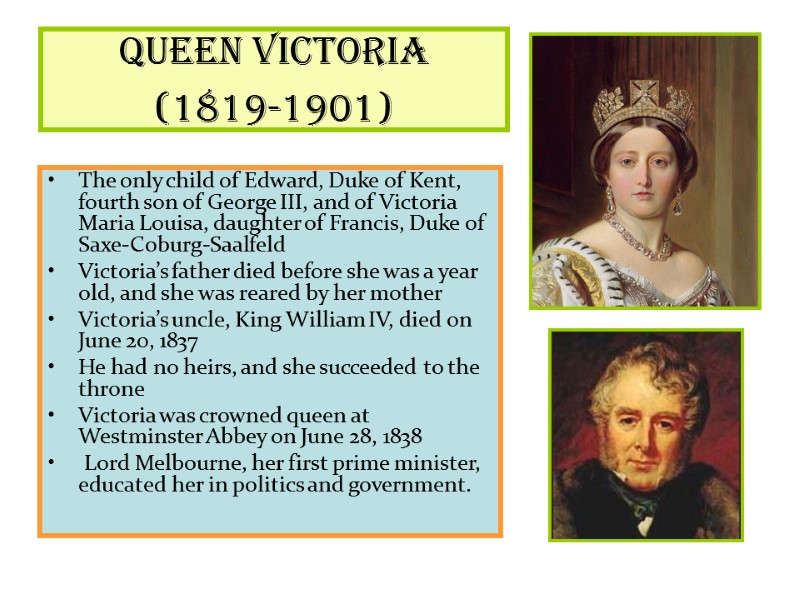
Queen Victoria (1819-1901) The only child of Edward, Duke of Kent, fourth son of George III, and of Victoria Maria Louisa, daughter of Francis, Duke of Saxe-Coburg-Saalfeld Victoria’s father died before she was a year old, and she was reared by her mother Victoria’s uncle, King William IV, died on June 20, 1837 He had no heirs, and she succeeded to the throne Victoria was crowned queen at Westminster Abbey on June 28, 1838 Lord Melbourne, her first prime minister, educated her in politics and government.
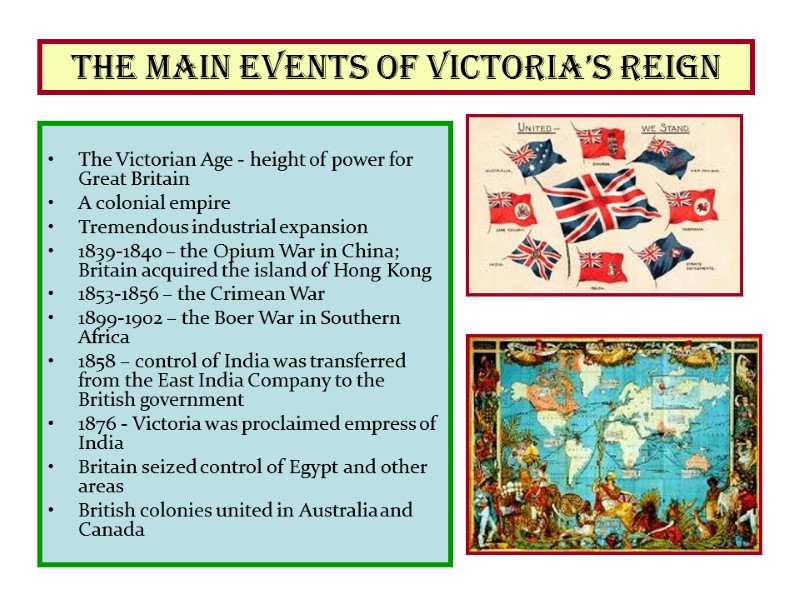
The main events of Victoria’s reign The Victorian Age - height of power for Great Britain A colonial empire Tremendous industrial expansion 1839-1840 – the Opium War in China; Britain acquired the island of Hong Kong 1853-1856 – the Crimean War 1899-1902 – the Boer War in Southern Africa 1858 – control of India was transferred from the East India Company to the British government 1876 - Victoria was proclaimed empress of India Britain seized control of Egypt and other areas British colonies united in Australia and Canada
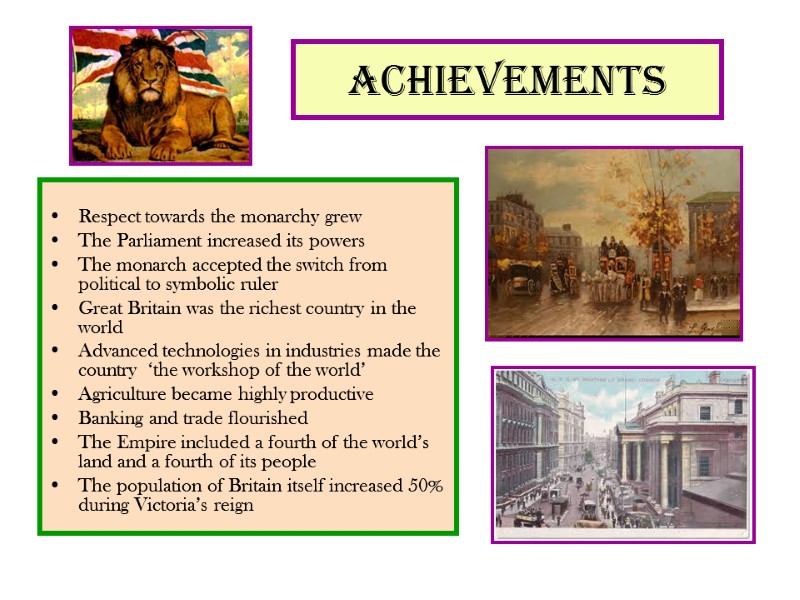
Achievements Respect towards the monarchy grew The Parliament increased its powers The monarch accepted the switch from political to symbolic ruler Great Britain was the richest country in the world Advanced technologies in industries made the country ‘the workshop of the world’ Agriculture became highly productive Banking and trade flourished The Empire included a fourth of the world’s land and a fourth of its people The population of Britain itself increased 50% during Victoria’s reign
11384-powerpoint_constitutional_monarchy.the_british_empire.ppt
- Количество слайдов: 24

